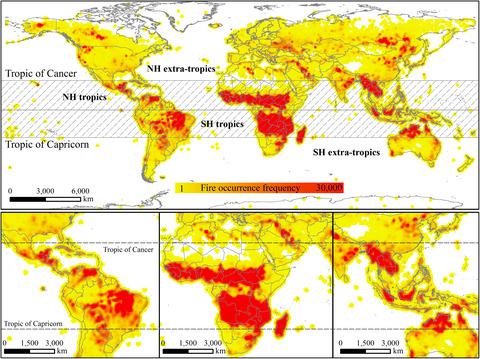当前位置:
X-MOL 学术
›
Glob. Change Biol.
›
论文详情
Our official English website, www.x-mol.net, welcomes your
feedback! (Note: you will need to create a separate account there.)
Occurrence frequencies and regional variations in Visible Infrared Imaging Radiometer Suite (VIIRS) global active fires.
Global Change Biology ( IF 10.8 ) Pub Date : 2020-03-11 , DOI: 10.1111/gcb.15034 Peng Li 1, 2, 3 , Chiwei Xiao 1, 2, 3, 4 , Zhiming Feng 1, 2, 5 , Wenjun Li 1, 2 , Xianzhou Zhang 1, 2
Global Change Biology ( IF 10.8 ) Pub Date : 2020-03-11 , DOI: 10.1111/gcb.15034 Peng Li 1, 2, 3 , Chiwei Xiao 1, 2, 3, 4 , Zhiming Feng 1, 2, 5 , Wenjun Li 1, 2 , Xianzhou Zhang 1, 2
Affiliation

|
Active fires are considered to be the key contributor to, and critical consequence of, climate change. Quantifying the occurrence frequency and regional variations in global active fires is significant for assessing carbon cycling, atmospheric chemistry, and post-fire ecological effects. Multi-scale variations in fire occurrence frequencies have still never been fully investigated despite free access to global active fire products. We analyzed the occurrence frequencies of Visible Infrared Imaging Radiometer Suite (VIIRS) active fires at national, pan-regional (tropics and extra-tropics) to global scales and at hourly, monthly, and annual scales during 2012-2017. The results revealed that the accumulated occurrence frequencies of VIIRS global active fires were up to 12,193×104 , yet exhibiting slightly fluctuations annually and with respect to the 2014-2016 El Niño event, especially in 2015. 35.52% of VIIRS active fires occurred from July to September, particularly in August (13.06%), and typically between 10:00 Greenwich Mean Time (GMT) and 13:00 GMT (42.96%) and especially at 11:00 GMT (17.65%). The total counts conform to a bimodal pattern with peaks in 5°-11°N (18.01%) and 5°-18°S (32.46%), respectively, alongside a unimodal distribution in terms of longitudes between 15°E and 30°E (32.34%). Tropical annual average of active fire (1,496.81×104 ) accounted for 75.83%. Nearly 30% were counted in Brazil, the Democratic Republic of the Congo (DRC), Indonesia and Mainland Southeast Asia (MSEA). Fires typically occurred between June (or August) and October (or November) with far below-average rainfall in these countries, while those in MSEA primarily occurred between February and April during the dry season. They were primarily observed between 00:00 GMT and 02:00 GMT, between 12:00 and 14:00 within each Zone Time. We believed that VIIRS global active fires products are useful for developing fire detection algorithms, discriminating occurrence types and ignition causes via correlation analyses with physical geographic elements, and assessment their potential impacts.
中文翻译:

可见红外成像辐射计套件(VIIRS)全球活跃火灾的发生频率和区域变化。
积极的大火被认为是造成气候变化的关键因素,也是造成气候变化的关键后果。量化全球活跃火灾的发生频率和区域变化对于评估碳循环,大气化学和火灾后的生态影响具有重要意义。尽管可以免费获得全球活跃的消防产品,但从未对火灾发生频率的多尺度变化进行全面研究。我们分析了可见红外成像辐射计套件(VIIRS)在全球,全球范围以及2012-2017年期间每小时,每月和每年的规模在国家,泛地区(热带和超热带)发生的火灾的发生频率。结果表明,VIIRS全球主动火的累积发生频率高达12,193×104,。但相对于2014-2016年厄尔尼诺事件,尤其是在2015年,每年都有轻微波动。七月至九月,尤其是八月(13.06%),通常是格林尼治标准时间10:00,发生了35.52%的VIIRS活跃火灾。 (GMT)和13:00 GMT(42.96%),尤其是在11:00 GMT(17.65%)。总计数符合双峰模式,峰值分别在5°-11°N(18.01%)和5°-18°S(32.46%)处,并且在15°E到30°之间的经度方面呈单峰分布E(32.34%)。热带活跃火年均数(1,496.81×104)占75.83%。在巴西,刚果民主共和国(DRC),印度尼西亚和东南亚大陆(MSEA)中,有近30%的人参与了调查。这些国家/地区通常在6月(或8月)至10月(或11月)之间发生大火,降雨量低于平均水平,而MSEA中的那些主要发生在2月到4月的旱季之间。主要在每个区域时间的格林尼治标准时间00:00到格林尼治标准时间02:00之间以及12:00到14:00之间观察到它们。我们认为,VIIRS全球主动火灾产品可用于开发火灾探测算法,通过与物理地理元素的相关分析来区分发生类型和起火原因,并评估其潜在影响。
更新日期:2020-04-22
中文翻译:

可见红外成像辐射计套件(VIIRS)全球活跃火灾的发生频率和区域变化。
积极的大火被认为是造成气候变化的关键因素,也是造成气候变化的关键后果。量化全球活跃火灾的发生频率和区域变化对于评估碳循环,大气化学和火灾后的生态影响具有重要意义。尽管可以免费获得全球活跃的消防产品,但从未对火灾发生频率的多尺度变化进行全面研究。我们分析了可见红外成像辐射计套件(VIIRS)在全球,全球范围以及2012-2017年期间每小时,每月和每年的规模在国家,泛地区(热带和超热带)发生的火灾的发生频率。结果表明,VIIRS全球主动火的累积发生频率高达12,193×104,。但相对于2014-2016年厄尔尼诺事件,尤其是在2015年,每年都有轻微波动。七月至九月,尤其是八月(13.06%),通常是格林尼治标准时间10:00,发生了35.52%的VIIRS活跃火灾。 (GMT)和13:00 GMT(42.96%),尤其是在11:00 GMT(17.65%)。总计数符合双峰模式,峰值分别在5°-11°N(18.01%)和5°-18°S(32.46%)处,并且在15°E到30°之间的经度方面呈单峰分布E(32.34%)。热带活跃火年均数(1,496.81×104)占75.83%。在巴西,刚果民主共和国(DRC),印度尼西亚和东南亚大陆(MSEA)中,有近30%的人参与了调查。这些国家/地区通常在6月(或8月)至10月(或11月)之间发生大火,降雨量低于平均水平,而MSEA中的那些主要发生在2月到4月的旱季之间。主要在每个区域时间的格林尼治标准时间00:00到格林尼治标准时间02:00之间以及12:00到14:00之间观察到它们。我们认为,VIIRS全球主动火灾产品可用于开发火灾探测算法,通过与物理地理元素的相关分析来区分发生类型和起火原因,并评估其潜在影响。










































 京公网安备 11010802027423号
京公网安备 11010802027423号